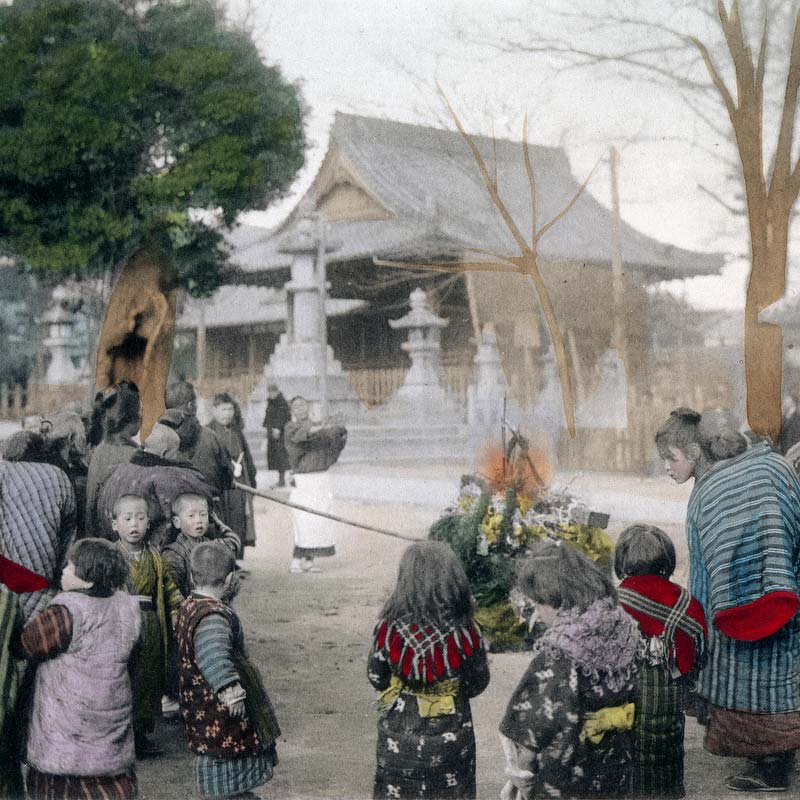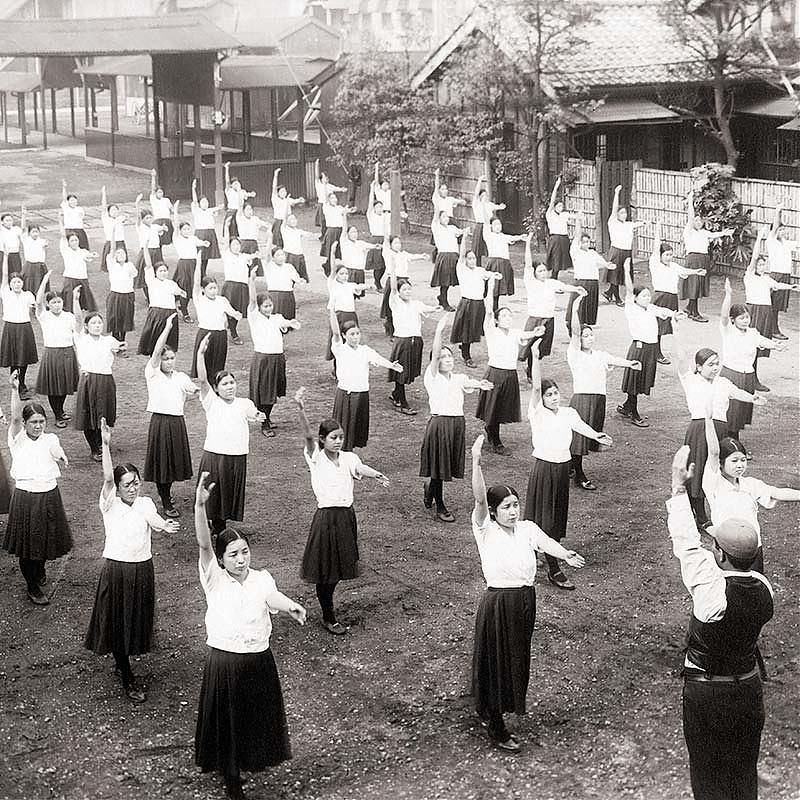Personnel welcomes an arriving customer at a Ryokan (Japanese inn) by sitting on the floor and bowing deeply. A scene that can still be seen in Ryokan all over Japan today.
The Ryokan has its roots in the Fuseya (布施屋), these were free rest-houses used during the Nara Period (710-784). As there was no accommodation yet at this time, travelers were forced to sleep outside, exposed to the elements and bandits. Getting food on long trips was a challenge and as a result many travelers died of starvation. To make travel less dangerous, Buddhist priests set up the Fuseya. It was also during the Nara Period that an organized system of roads was developed around the capital, which must have encouraged travel.
During the Heian Period (794-1185), it became very popular among the reigning elite to go on a pilgrimage. Pilgrims would stay at Shoen (荘園), manors owned by powerful families, temples and shrines, as well as at temple buildings. Temple accommodations would eventually develop into Shukubo (宿坊). Today Shukubo still exist and are open as lodgings to the general public.
Something that started to look like a real inn developed during the Kamakura Period (1185-1333). They were called Kichin-yado (木賃宿). Guests just paid for firewood at these cheap inns and cooked their own meals.
As Tokugawa Ieyasu started to construct highways throughout the newly united country from slightly before the beginning of the Edo Period (1603-1868), lodging became more important. This became even more so when the economy developed and trade increased. This gave rise to Hatago (旅籠), inns where meals were served. By the second half of the Edo Period few Kichin-yado were left and the Hatago had become the norm.
Besides the Hatago, there were Honjin (本陣) and Waki-honjin (脇本陣), official inns for government officials at the way-stations along the highways. These became extremely important because of the so called Sankin Kotai system, which forced Daimyo (feudal lords) and their entourage to spent part of the year in Edo, far away from their homes.
Especially thanks to the Sankin Kotai and pilgrimages there was very heavy traffic on the new highways. Because virtually all this travel was on foot and the way-stations were only at a day’s walking distance removed from each other, an incredible large number of inns started to flourish along these roads.
Although the general public was officially not allowed to travel during the Edo Period, people could go on pilgrimages and other religious trips which naturally made them extremely popular. Short trips to hot springs and famous tourist attractions were generally also permitted. Many inns were built at these resorts and many exist to this day, now as Ryokan.
As travel restrictions were removed with the onset of the Meiji Period (1863-1912) and railways were developed all over Japan, people started to travel just for leisure. With the termination of the Sankin Kotai system and the fading away of travel by foot, the old way-stations and their inns slowly faded away. But enterprising entrepreneurs were quick to see the opportunities offered by railway travel and near the nation’s newly built stations Ryokan started to sprout up like mushrooms.
Initially, they were similar to the old Hatago, but after the end of WWII, many new Ryokan were built of concrete. And although these days there are some 55,000 ryokan in Japan, traditional wooden ones have become rather rare and usually quite expensive. Anybody who has ever stayed in one, knows that there is really nothing like a traditional wooden Ryokan in a beautiful natural setting. The experience is absolutely unsurpassed.
Notes
1 For more information about Ryokan, visit the site of the Japan Ryokan Association.
Published
Updated
Reader Supported
Old Photos of Japan aims to be your personal museum for Japan's visual heritage and to bring the experiences of everyday life in old Japan to you.
To enhance our understanding of Japanese culture and society I track down, acquire, archive, and research images of everyday life, and give them context.
I share what I have found for free on this site, without ads or selling your data.
Your support helps me to continue doing so, and ensures that this exceptional visual heritage will not be lost and forgotten.
Thank you,
Kjeld Duits
Reference for Citations
Duits, Kjeld (). 1890s: Welcoming a Guest, OLD PHOTOS of JAPAN. Retrieved on December 12, 2025 (GMT) from https://www.oldphotosjapan.com/photos/243/welcoming-a-guest




Mr. T
Very interesting photo. One question I have, the article mentions traveling by foot extensively in Japan, when did horses arrive in Japan? Where did they come from? China? We horses in Japan a long, long time ago?
#000046 ·
Kjeld Duits (Author)
Good question! I was planning to introduce this with a photo of a packing horse later this year. Horses were used by Samurai and Daimyo, but other people did not use them to travel. Horse-drawn carriages didn’t make their appearance until the Meiji Period when they were introduced by foreigners. Transporting farm produce, straw etc. on horseback was common, but the person leading the horse would walk. I haven’t done any research yet about when horses first arrived in Japan and from where, but they are mentioned in very early records, so they have been around for a long time.
#000047 ·
Mr. T
Thanks for the answer. It is helpful for me as I try to understand how Japan evolved. Horses were introduced in the Americas by the Spanish.
#000048 ·
Kjeld Duits (Author)
Actually, Japan has its own native horses, but their origin is still a great controversy among scientists. If you really want to go deep into genetic research done on the origins, I suggest reading the following scientific paper:
.
Ken NOZAWA, Takayoshi SHOTAKE, Shin’ichi ITO and Yoshi KAWAMOTO. Phylogenetic Relationships among Japanese Native and Alien Horses Estimated by Protein Polymorphisms (pdf file). J. Equine Sci.. Vol. 9: 53-69. (1998).
#000050 ·
Ilshat Khusnutdinov
Hi. It seems that I accidentally discovered the author-photographer of many of your photos without authorship. John Lawson Stoddard (April 24, 1850 – June 5, 1931) was an American teacher, writer, and photographer. (https://en.wikipedia.org/wiki/John_Lawson_Stoddard )
In his book (Japan: illustrated and decorated with one hundred and thirty-eight reproductions of photographs, 1897) I found many of your photographs. And this one too. If, of course, these are his pictures. :)
You can view this book here – https://babel.hathitrust.org/cgi/pt?id=njp.32101054570955&seq=1
#000846 ·
Kjeld Duits (Author)
@Ilshat Khusnutdinov: You are tumbling into the notoriously confusing world of attributing vintage photographs of Japan.
Photographers published each others photographs without crediting each other, making it extremely difficult to correctly attribute the photographer of an image. Often, photographers even put their own numbering system on the photographs of other photographers.
This is also true for Stoddard. We know that he travelled to Japan with a photographer, but we also know from his biography, written by D. Crane Taylor, that he mostly purchased images from local photographers or other sources. This gave him more time to do his research.
Some of the images in his book date from before his visits, and can be attributed to other photographers.
#000847 ·
Ilshat Khusnutdinov
So I fell for it. :(
I’m sorry.
#000848 ·
Kjeld Duits (Author)
@Ilshat Khusnutdinov: No problem at all. It is difficult to know all the intricacies of vintage Japanese photography without extensive study. It is a complex subject area that has only been studied intensively during the past few decades. There is still a lot that is unknown.
#000849 ·
Noel
From the caption we can attribute the photo to Adolfo Farsari.
#000851 ·
Kjeld Duits (Author)
@Noel: Thanks, Noel. Excellent observation. I just noticed that I published this article in 2008, just a year after I started collecting and probably before I purchased Terry Bennett’s Old Japanese Photographs: Collectors’ Data Guide. Just checked it and he attributes this image to Farsari as well. I will adjust the attribution right away.
#000852 ·
Kjeld Duits (Author)
@Noel: I had already attributed this image to Farsari on MeijiShowa and in the metadata of the image, I just notice now. Must have forgotten to adjust it here. Once again, thanks!
#000853 ·